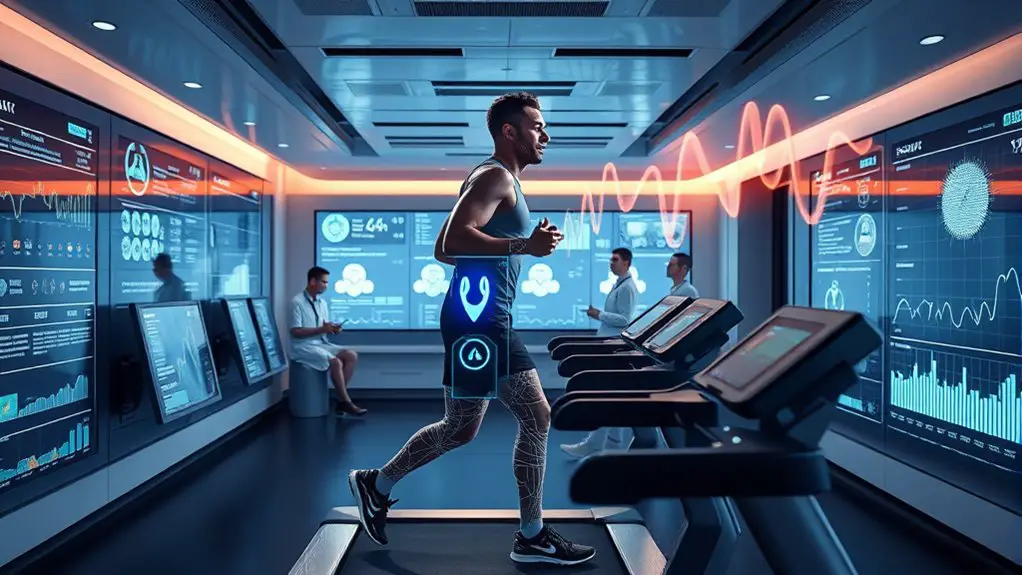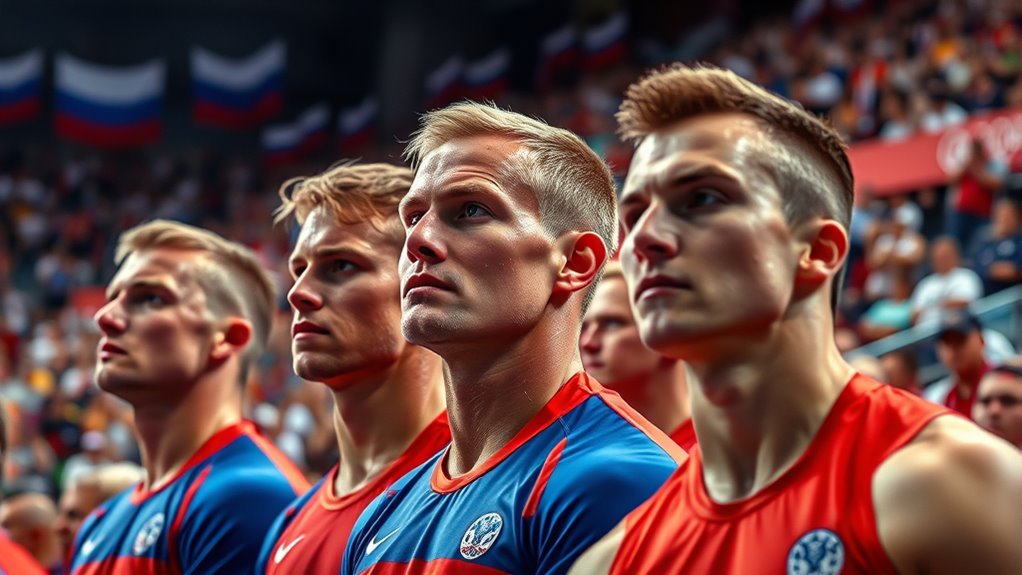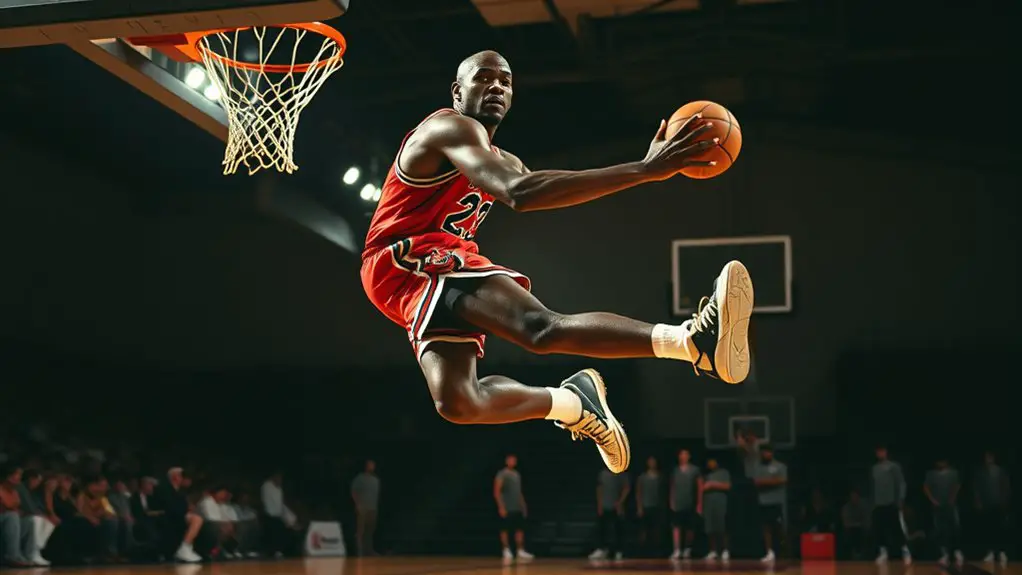Biohacking plays an essential role in elite sports by helping athletes optimize both physical performance and mental focus. Techniques like tailored diets, sleep optimization, and advanced recovery methods enhance endurance and accelerate recovery. Wearable technology allows you to monitor performance in real-time, making it easier to adjust training strategies. While it empowers athletes, biohacking also raises ethical questions about fairness in competition. Discovering deeper insights into these aspects can provide a clearer picture of biohacking's impact.
Understanding Biohacking: A Brief Overview
Biohacking, while often seen as a fringe movement, has gained traction in elite sports as athletes seek every possible edge in performance. You might think of biohacking as a personal revolution, where you take control of your body and mind. It's about using innovative techniques to optimize your physical and mental capabilities, giving you the freedom to push boundaries.
From tailored diets and sleep optimization to wearable tech that tracks your health metrics, biohacking offers tools to enhance your training. You don't have to settle for the status quo; instead, you can experiment and find what works best for you. The beauty of biohacking is its adaptability; it encourages you to listen to your body and respond with tailored strategies. Whether it's intermittent fasting or cold exposure, each method is a step toward releasing your full potential and achieving your goals. Embrace the journey of self-discovery! Additionally, incorporating biofeedback techniques can significantly improve your mental conditioning and focus, further enhancing your athletic performance.
The Science Behind Biohacking Techniques
While many biohacking techniques may seem unconventional, they're often grounded in scientific principles that enhance athletic performance. By leveraging insights from fields like neuroscience and physiology, you can tap into your body's natural capabilities. For instance, techniques such as neurofeedback help you optimize mental focus and reduce anxiety. This isn't just fluff; studies show brainwave training can improve reaction times and decision-making skills. Additionally, positive self-talk plays a crucial role in enhancing confidence and motivation, further supporting athletic success.
Additionally, practices like cold exposure and heat therapy can promote recovery and boost endurance. These methods trigger biological responses that enhance blood circulation and reduce inflammation. When you embrace these techniques, you're not just following trends; you're engaging with your body on a deeper level.
Ultimately, biohacking gives you the freedom to explore what works best for you, allowing for a personalized approach to peak performance. Embrace the science, and watch how it transforms your athletic journey.
Nutrition and Supplementation Strategies for Athletes
Improving athletic performance goes beyond mental and physical techniques; nutrition and supplementation play a pivotal role in your overall training regimen. Properly fueling your body can enhance endurance, recovery, and muscle growth, giving you the edge you seek. Additionally, prioritizing adequate protein intake can significantly accelerate muscle recovery after intense workouts.
| Nutrient | Benefits |
|---|---|
| Protein | Supports muscle repair and growth |
| Carbohydrates | Provides energy for workouts |
| Omega-3s | Reduces inflammation |
| Vitamins | Boosts immune function |
Balancing macronutrients and incorporating high-quality supplements can help you optimize your performance. Consider experimenting with timing your meals and supplements around workouts to maximize their benefits. Remember, your body thrives on the right combination of nutrients, so don't shy away from tailoring your diet to fit your unique needs and aspirations. Embrace the freedom to explore what works best for you, and watch your athletic performance soar to new heights.
Wearable Technology and Performance Monitoring
Wearable technology is changing how you monitor your performance in real time, giving you insights into your body like never before. With this data, you can implement enhanced recovery techniques tailored specifically to your needs. Additionally, real-time heart rate monitoring allows you to optimize your workouts and ensure safety by making informed adjustments based on your heart rate. Let's explore how these advancements can elevate your training and competition outcomes.
Real-time Data Analysis
As athletes push the boundaries of human performance, real-time data analysis through cutting-edge wearable technology has become essential for optimizing training and competition. These devices provide instant feedback, empowering you to make informed decisions on the fly.
| Metric | Importance | Example Use |
|---|---|---|
| Heart Rate | Monitors exertion | Adjusting intensity |
| GPS Tracking | Measures distance | Optimizing routes |
| Sleep Quality | Enhances recovery | Tailoring rest days |
| Body Temperature | Prevents overheating | Managing hydration |
With this data at your fingertips, you can truly embrace your potential, adapting your approach in real-time. Biohacking isn't just about technology; it's about freedom—freedom to push, adapt, and thrive.
Enhanced Recovery Techniques
While traditional recovery methods have their place, integrating advanced wearable technology into your routine can considerably enhance your post-performance recovery. These devices track essential metrics like heart rate, sleep patterns, and muscle recovery, giving you insights that help optimize your downtime. Imagine having the power to analyze your body's responses in real-time, allowing you to adjust your recovery protocols as needed. With performance monitoring, you can identify what works best for you, minimizing the guesswork in your routine. This freedom to tailor your recovery not only speeds up healing but can also boost your overall performance. Embrace these innovative tools, and watch how they transform your recovery experience into a more efficient and personalized journey.
Recovery and Regeneration: Innovative Approaches
When it comes to recovery and regeneration, you've got a range of innovative approaches at your fingertips. Advanced recovery technologies, like cryotherapy and electrical stimulation, can enhance your healing process, while nutritional optimization strategies guarantee your body gets the fuel it needs to bounce back. Understanding these tools can help you maximize your performance and maintain your edge in elite sports. Incorporating ice baths into your routine can further accelerate recovery by reducing muscle soreness and inflammation.
Advanced Recovery Technologies
Advanced recovery technologies have revolutionized how elite athletes approach their post-performance routines, making it easier than ever to enhance recovery and regeneration. You can now tap into tools like cryotherapy, infrared saunas, and electrical stimulation devices that help soothe sore muscles and reduce inflammation. These innovations empower you to take control of your recovery process, ensuring you bounce back stronger and faster. You're no longer just relying on traditional methods; you've got a whole arsenal of advanced options at your fingertips. With personalized recovery plans tailored to your specific needs, you can optimize your downtime and unlock your full potential. Embrace these technologies and experience the freedom that comes with faster recovery and improved performance.
Nutritional Optimization Strategies
To maximize recovery and regeneration, nutritional optimization strategies have become vital for elite athletes. You need to fuel your body with the right nutrients at the right times. Focus on whole foods rich in antioxidants, healthy fats, and high-quality proteins to support muscle repair. Incorporating specific supplements, like omega-3 fatty acids and BCAAs, can also enhance recovery. Hydration plays a significant role, so don't forget to replenish fluids lost during training. Timing matters too; eating a balanced meal or snack within 30 minutes post-workout can kickstart your recovery process. Experiment with meal timing and macronutrient ratios to find what works best for you. Embrace these strategies, and you'll reveal your full potential in your athletic journey.
Mental Optimization: Biohacking the Mind
Although mental resilience is often overlooked, optimizing cognitive function has become a crucial aspect of biohacking in elite sports. You can enhance your mental game and gain an edge over competitors by employing various techniques. Here are some strategies to take into account:
Enhancing mental resilience is key in elite sports; optimize cognitive function for a competitive edge.
- Meditation: Practicing mindfulness can sharpen your focus and reduce anxiety.
- Neurofeedback: This technology helps train your brain to operate more efficiently.
- Cognitive Training Apps: Engaging in brain games can improve reaction times and decision-making.
- Sleep Optimization: Prioritizing restorative sleep enhances memory consolidation and overall performance.
- Nootropics: Certain supplements can boost mental clarity and cognitive function. Integrating meditation into your training routine can also help athletes access their full potential by reducing stress levels.
Ethical Considerations in Biohacking for Sports
As the pursuit of peak performance intensifies, ethical considerations in biohacking for sports have come under scrutiny. You might wonder where to draw the line between enhancement and unfair advantage. While biohacking can empower athletes to optimize their abilities, it can also lead to a slippery slope of manipulation, blurring the lines of fair competition.
Think about the implications of using genetic editing or advanced supplements. Are you crossing an ethical boundary, or are you simply exercising your freedom to enhance? The challenge lies in balancing personal freedom with the integrity of the sport.
It's essential to reflect on the long-term effects not just on individuals but on the spirit of competition itself. When everyone has access to biohacking tools, will true talent and hard work still shine through? As you explore these advancements, keep questioning the ethical landscape surrounding them—your choices matter.
Frequently Asked Questions
What Are the Risks Associated With Biohacking in Sports?
When you consider biohacking in sports, you're facing risks like potential injuries, health complications, and ethical dilemmas. It's essential to weigh these risks against the benefits before diving into any extreme enhancements.
How Do Elite Athletes Personalize Their Biohacking Strategies?
Elite athletes personalize their biohacking strategies by experimenting with nutrition, sleep patterns, and training regimens. They're constantly evaluating their bodies' responses, fine-tuning approaches to enhance performance, recovery, and overall well-being tailored just for them.
Can Biohacking Techniques Enhance Recovery After Injuries?
Absolutely, you can enhance your recovery with biohacking techniques. By optimizing nutrition, sleep, and using technology, you'll speed up healing and get back to what you love faster, all while maintaining your freedom and independence.
What Role Does Genetics Play in Biohacking Effectiveness?
Genetics is the blueprint of your body, influencing how you respond to biohacking. If you know your genetic makeup, you can tailor techniques for ideal results, releasing your full potential and embracing true freedom in performance.
Are There Regulations Governing Biohacking Practices in Professional Sports?
Yes, there're regulations governing biohacking in professional sports. You need to be aware of these rules to avoid penalties. It's crucial to balance your desire for enhancement with compliance to maintain fair competition and integrity.




